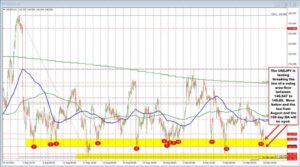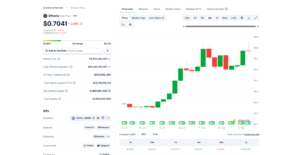Anchored VWAP: Trading Strategies & How To Use It

Anchored Volume Weighted Average Price (VWAP) is a powerful indicator that helps traders analyze price movements. Unlike the traditional VWAP calculation that starts at the beginning of the day, it enables you to set an anchor point, offering a more precise understanding of market conditions. This tool is particularly useful for determining support and resistance levels because it considers price and volume data from a specific period.
Using Anchored VWAP for technical analysis allows you to track market behavior, identify trends, and find optimal entry points for opening trades. Anchored VWAP is widely used in trading, especially in conditions of elevated market volatility, helping traders find key price levels, gauge market sentiment, and make informed trading decisions.
The article covers the following subjects:
Major Takeaways
-
The Anchored VWAP indicator allows you to apply the volume-weighted average price to a specific anchor point, improving the analysis of price movement.
-
Unlike traditional VWAP, it takes into account market conditions from a specified point in time, rather than throughout the entire trading day.
-
The Anchored VWAP indicator helps you find support and resistance levels, track trends, and determine market entry points.
-
This tool is particularly indispensable for analyzing market volatility and assessing market sentiment.
-
AVWAP is often employed in trading strategies across various financial markets, including stocks and currency pairs.
-
The tool settings can be customized to different time frames, increasing the accuracy of technical analysis.
-
Traders use the Anchored VWAP indicator together with the RSI and MACD to track market behavior more effectively.
-
This type of tool is especially relevant for traders who use price movement analysis.
What Is The Anchored VWAP?
Anchored VWAP is an advanced indicator that calculates the volume-weighted average price using an anchor point. Unlike traditional VWAP, which resets at the start of every new trading session, Anchored VWAP enables traders to select the starting point of the calculation. This makes it particularly useful for analyzing market conditions after significant events, such as news releases, support and resistance breakouts, or the beginning of a new trend.
This tool helps you assess the impact of large trades on price movements, identify trends, and determine key levels. Anchored VWAP takes market volatility and sentiment into account, allowing you to find the best entry prices. Thanks to its flexibility, AVWAP can be used in various trading strategies, including intraday trading, medium-term strategies, and analyzing large price movements.
Furthermore, Anchored VWAP can be applied to different time frames, adjusting to specific market situations — especially when it comes to analyzing highly volatile stocks. The tool’s calculation mechanism makes it useful for gaining insight into the actions of major market players and analyzing the impact of significant events on prices.
How to Calculate Anchored VWAP Formula?
The Anchored VWAP calculation formula is based on the volume-weighted average price, but unlike traditional VWAP, it starts from a specified anchor point.
The formula looks like this:
where:
-
Pi — average value of a candlestick (High + Low + Close) / 3;
-
Vi — volume of this candlestick;
-
∑(Pi×Vi) — the total product of price and volume from the anchor point;
-
∑Vi — total volume from the anchor point.
Thus, Anchored VWAP calculates the weighted average price based on price and volume data starting from the selected point, allowing traders to better assess market conditions, analyze the impact of large orders, and identify key support and resistance levels. Anchored VWAP is particularly useful when evaluating significant price movements and finding optimal entry points.
Difference Between VWAP and Anchored VWAP
Although both VWAP and Anchored VWAP measure the volume-weighted average price, they work differently. VWAP is calculated from the start of the trading day and gets updated in real time, while Anchored VWAP lets traders pick a reference point for the calculation, making it more accurate for identifying key support and resistance levels.
|
Criteria |
VWAP |
Anchored VWAP |
|
Anchor point |
Start of a trading day |
Any |
|
Application |
Intraday trading analysis |
Long-term analysis of market conditions |
|
Flexibility |
Calculation from the trading day opening |
Allows you to evaluate the market from a specific point |
|
Data used |
Daily price and volume data |
Prices and volumes from a moment selected by the trader |
|
Main function |
Determining the average daily price |
Analysis of support and resistance levels |
|
Application in trading |
Suitable for scalping and day trading |
Medium-term strategies |
VWAP is useful for short-term trading, while Anchored VWAP allows you to tailor your analysis to key events affecting the market.
Anchored Volume Weighted Average Price vs. Moving Averages
Anchored VWAP, the SMA, and the EMA are two popular indicators used in technical analysis. Both help identify trends, but they have fundamental differences. Anchored VWAP calculates the volume-weighted average price from the anchor point, while moving averages calculate the average price over a certain period, disregarding trading volume. This makes Anchored VWAP more sensitive to market volatility and market participant activity.
|
Criteria |
Anchored VWAP |
SMA and EMA |
|
Calculation |
Weighted average price and volume |
Simple or exponential averaging |
|
Anchor point |
Achor point is determined by a trader |
Constantly updated |
|
Sensitivity |
Takes into account volumes and reflects market conditions |
Reacts only to price changes |
|
Data |
Prices and volume from the anchor point |
Prices for a specified period |
|
Main function |
Analysis of key support and resistance levels |
Identifies global trends |
|
Application |
Analyzing large orders and the impact of significant events |
Used in trend strategies |
Anchored VWAP better identifies key levels, while moving averages help track long-term trends. When used together, they provide more accurate entry points and allow you to take market psychology into account.
Choosing The Anchor Point
In Anchored VWAP, the anchor point plays a key role in the accuracy of the analysis. Unlike traditional VWAP, which resets at the start of the trading day, Anchored VWAP enables traders to select the starting time for calculations. This feature ensures that market conditions related to important events are taken into account and that the indicator can be adapted to the current market context.
Choosing the right anchor point has several advantages:
-
It helps determine support and resistance levels from the moment of a key event.
-
It allows you to assess the impact of large orders and market movements.
-
It enables you to find entry points based on market psychology.
-
It eliminates the impact of irrelevant price movements on your analysis.
How to Choose an Anchor Point
1. Trading day opening:
-
Anchored VWAP is suitable for short-term trading and analysis of intraday movements.
-
It helps determine the average daily price, taking into account trading volume.
2. Key level breakout:
-
The indicator shows where large market participants have placed their orders if the price breaks through a key support or resistance level.
-
It assesses the strength of an emerging trend.
3. Reaction to news:
-
Choosing the anchor point after an important news release allows you to understand how market sentiment has changed.
-
AVWAP helps analyze significant economic events or statements by the Fed.
4. Reversal point:
-
If a reversal signal appears on the price chart, such as a Price Action pattern, this can become a perfect anchor point.
-
It is often used in combination with technical indicators such as the RSI and MACD.
5. Onset of a strong trend movement:
Proper anchoring improves trading strategies, minimizes errors, and facilitates informed decision-making. Using multiple Anchored VWAPs enables you to accurately assess market conditions and find optimal entry points.
Interpreting Anchored VWAP
Anchored VWAP is a powerful indicator that helps traders analyze market conditions and identify trends by providing an objective measure of price movements. Its primary purpose is to show where the average volume-weighted price is positioned against the current price. Based on the position of the price relative to the Anchored VWAP line, traders can gauge market sentiment and pinpoint potential entry points.
How to Interpret Anchored VWAP Signals
1. The price is above the Anchored line:
-
This indicates a bullish market sentiment.
-
Traders view this signal as an opportunity to enter into long positions.
-
If the price tests the Anchored level from above and bounces back, this confirms the support level.
For example, after an important news release, the price fell sharply. The trader sets the anchor point when the news is released. If the price remains above the Anchored VWAP, this confirms the strength of the buyers.
2. The price is below the Anchored line:
-
If the price falls below the indicator line, this signals a bear market.
-
Any level where the Anchored line is retested from below can become a resistance level.
-
This is a favorable opportunity to find entry points into short positions.
For example, the uptrend begins to wane, and the price breaks through the Anchored VWAP line from above. If the price rebounds from the line and moves lower, this confirms the strength of the sellers and the likelihood of a deeper decline.
3. Flat market:
-
If the price fluctuates around the Anchored VWAP line, this indicates that there is no clear trend.
-
In this case, traders can use additional indicators such as the RSI or moving averages to clarify the direction of price movement.
For example, after a prolonged rally, the price is consolidating and moving alongside the Anchored VWAP, suggesting that there is a balance between buyers and sellers until the market establishes a clear trend.
4. Using several Anchored VWAP lines:
-
Setting multiple lines with different anchor points helps to identify long-term and short-term support and resistance levels.
-
This setup is especially useful for assessing trend strength and finding optimal entry points.
For example, one Anchored VWAP indicator is anchored to the swing low, and the second one – to the most recent breakout. This setup helps you see where major market participants are executing trades, revealing key levels and trends on different time frames.
Interpreting the Anchored indicator helps traders find key support and resistance levels, determine market volatility, and identify price trends. Using multiple Anchored lines on different time frames allows you to analyze stock movements and find optimal entry prices for trades. Combining Anchored with other indicators, such as the RSI, MACD, and moving averages, increases the accuracy of trading signals and helps avoid false entries.
Anchored VWAP Trading Strategies
AVWAP is used in the best trading strategies to help traders determine entry levels and analyze market conditions. It shows key support and resistance levels, allowing you to find the best trades. Let’s take a look at some trading strategies based on AVWAP.
Pullback to Anchored VWAP
The Anchored pullback strategy involves entering a trade after a correction to an indicator that acts as a support or resistance level. You should wait for the price to return to the Anchored level and for a confirmational signal, such as a candlestick pattern or increased volume, before opening a position. When prices bounce up from the Anchored, giving a buy signal, you can open positions in the direction of the trend. A breakout to the downside may be an opportunity to open short trades. To increase the reliability of the signal, you can use the top technical indicators, such as RSI or MACD.
Continuation/Momentum Trade
Anchored VWAP can track impulsive movements in a trend. If the price stays above the indicator line, it confirms a bullish impulse, and if it remains below the line, it confirms a bearish impulse. Open trades in the direction of the trend after the price retests the Anchored VWAP line. Monitor trading volume, as a sharp increase in liquidity strengthens the signal. This strategy is suitable for scalping and day trading. Remember to keep track of market conditions, as false breakouts occur more often when volatility is high, so it is worth waiting for the price to consolidate above the level before taking action.
Using AVWAP as Support or Resistance Level
AVWAP often acts as a dynamic support or resistance level, serving as one of the key lines to control price movement. In an uptrend, the price usually stays above the indicator, and when it returns to it, you can consider long trades. In a downtrend, Anchored acts as resistance, from which the price usually rebounds. Market sentiment and trading volume are used for confirmation. If the price slows down as it approaches the indicator line and then a reversal pattern appears, you can enter a trade.
Using AVWAP to Identify Breakouts or Breakdowns
When trading breakouts, Anchored serves as a key level to confirm whether the price has ended the consolidation phase. If the price breaks through the Anchored line from below with increased volume, this points to a bullish breakout. A breakout from above indicates a bearish movement. You can place orders after a confirming retest to avoid false breakouts. When trading breakouts, consider trends and additional factors such as news or the influence of major market players, as these can accelerate price movements.
Use Multiple Anchored VWAPs
Using multiple Anchored lines helps analyze trends and identify key levels. For example, one line is anchored to the beginning of a trend, another to a swing high or low. Their intersection or narrowing of the range reveals an entry point. This method is used in medium- and long-term strategies. The more confirmations from different Anchored lines, the stronger the entry level. This is especially true when analyzing stocks traded by large institutional investors. You can also use different time frames to track global and local support and resistance levels. The indicator translates market movements into objective data, helping traders better interpret price behavior and the actions of major players.
Anchored VWAP Settings And Time Frames
Anchored VWAP is a flexible indicator that can be customized for different time frames and trading styles. Depending on your goals, it can be used for intraday trading, medium-term, and long-term strategies. The versatility of this tool allows you to take market conditions into account when choosing the optimal anchor points.
Basic Settings for Anchored VWAP
1. Choosing an anchor point:
-
start of the trading day for short-term analysis;
-
breakout of a key support or resistance level;
-
release of news or important economic data;
-
swing lows or highs for trend assessment.
2. Line color and thickness:
-
You can change the line display style for convenience by highlighting important levels.
-
You can use multiple Anchored lines with different colors on the chart to analyze long-term and short-term movements.
3. Additional deviation levels:
-
Setting deviations (+1, -1 standard deviation) helps to determine the limits of market volatility.
-
These levels allow you to find overbought and oversold zones.
Recommendations for time frames:
-
Lower time frames (M1–M15) are used for scalping and quick trades.
-
Medium-term time frames (H1–H4) are suitable for intraday trading and finding trend confirmations.
-
Higher timeframes (D1–W1) are used for analyzing global trends and long-term investing.
Anchored settings should be tailored to your strategy. Using multiple lines on different time frames helps to find strong support and resistance levels and analyze market behavior.
Additional technical indicators such as moving averages, the RSI, and MACD can improve the accuracy of your trading decisions.
Anchored VWAP Pros and Cons
Anchored VWAP is an effective indicator that allows you to analyze market conditions and identify key levels. However, like any tool, it has its advantages and disadvantages.
Advantages of Anchored VWAP:
-
Flexibility in analysis. The ability to select an anchor point allows you to tailor the indicator to different trading situations.
-
Volume consideration. Unlike moving averages, Anchored VWAP takes trading volume into account, making it more accurate in assessing market movements.
-
Identifying support and resistance levels. The tool helps you find key levels that the price may rebound from or break through.
-
Applicability to different time frames. It works both in intraday trading and long-term investing.
-
Use in trading strategies. It is suitable for determining entry points, identifying impulse movements, and spotting false breakouts.
Disadvantages of Anchored VWAP:
-
Dependence on the choice of an anchor point. An incorrect choice of an anchor point can lead to a distorted analysis.
-
Delay in calculations. On higher time frames, it may give signals with a delay, especially when volatility is high.
-
Need for additional confirmation. Anchored is best used with technical indicators such as the RSI, MACD, or moving averages for more accurate analysis.
Anchored VWAP is a valuable tool, but its effectiveness depends on the market context and other factors. When properly configured and combined with other technical indicators, it improves signal accuracy.
Conclusion
Anchored VWAP is a versatile indicator that helps traders analyze market conditions, identify support and resistance levels, and find entry points for trades. Its key advantage is the ability to select an anchor point, making it more flexible than traditional VWAP.
The tool is effective for both intraday trading and analyzing long-term trends. However, its use requires the correct interpretation of signals and combination with other technical indicators.
When used correctly, Anchored VWAP becomes a powerful tool for analyzing price movements, improving trading strategies, and increasing profitability.
The content of this article reflects the author’s opinion and does not necessarily reflect the official position of LiteFinance broker. The material published on this page is provided for informational purposes only and should not be considered as the provision of investment advice for the purposes of Directive 2014/65/EU.
According to copyright law, this article is considered intellectual property, which includes a prohibition on copying and distributing it without consent.







